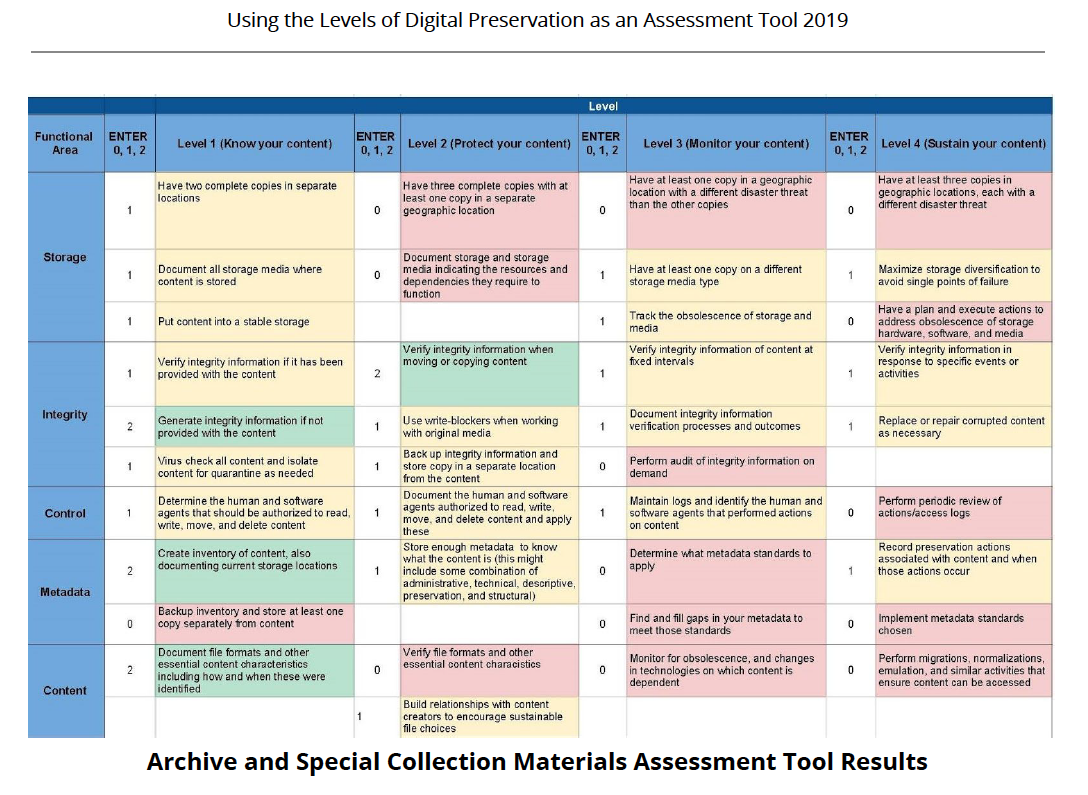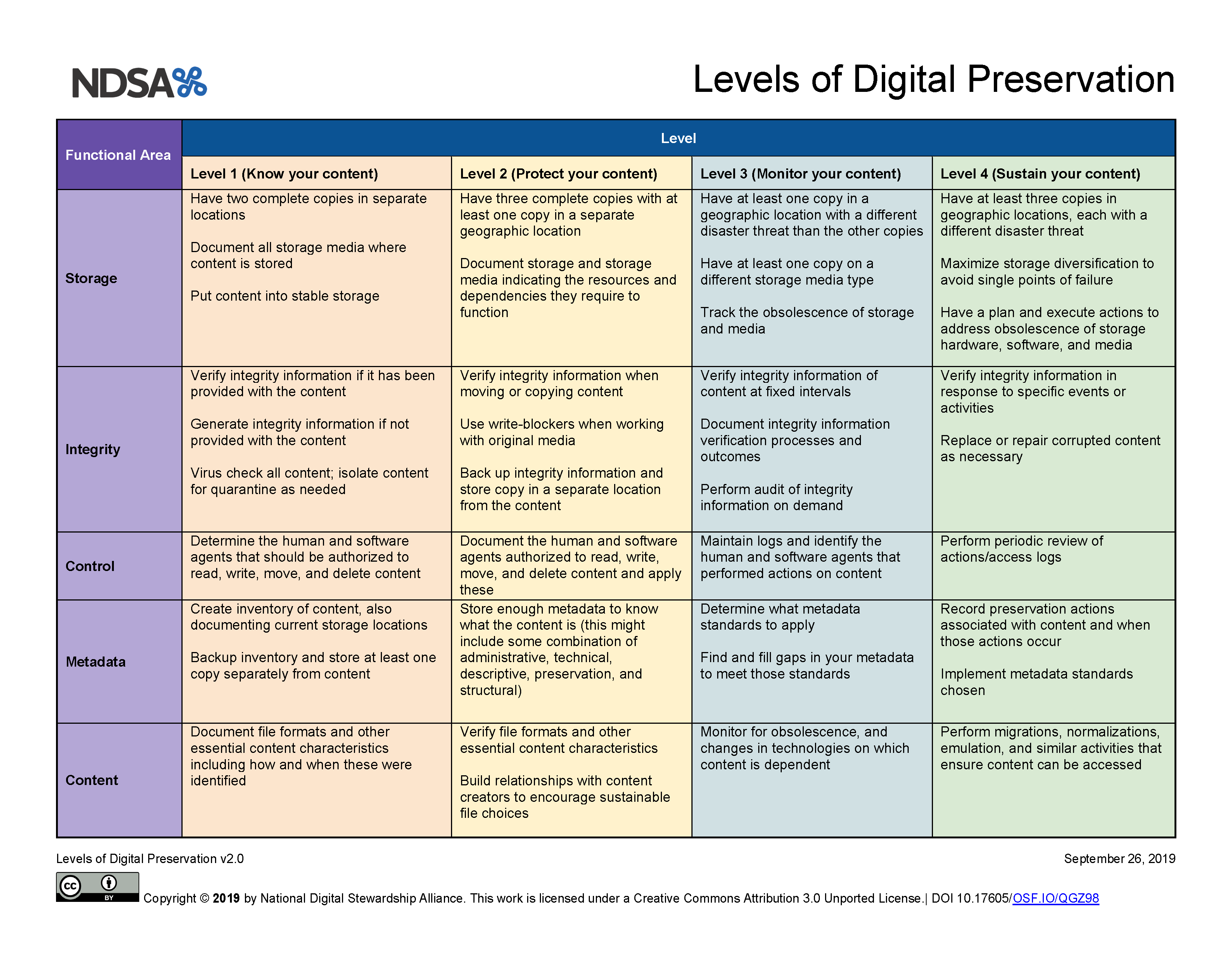 The Levels of Digital Preservation (LoDP or Levels) was first released in 2013 and became a foundational set of practices in the field, used by organizations across the globe. Members of the NDSA Coordinating Committee met in February 2018 to discuss coordinating the disparate attempts to update the 2013 Levels. Based on community feedback, this group proposed including additional materials and guidance resources alongside the revision.
The Levels of Digital Preservation (LoDP or Levels) was first released in 2013 and became a foundational set of practices in the field, used by organizations across the globe. Members of the NDSA Coordinating Committee met in February 2018 to discuss coordinating the disparate attempts to update the 2013 Levels. Based on community feedback, this group proposed including additional materials and guidance resources alongside the revision.
We discovered in this process that the LoDP had been far more widely adopted then previously known and as a result, many community members were interested in participating in the revision process. Nearly 150 individuals responded to our call. Interested parties were asked to self-select their area of interest and level of participation.
Five groups were formed with three being able to start immediately, the Implementation subgroup, the Revision subgroup, and the Assessment subgroup. The work of the other two subgroups, Curatorial and the Teaching and Advocacy, were predicated on the outcomes of the initial groups and are expected to be available at the end of 2020. The work of the Assessment, Implementation, and Revision subgroups are included in this application and described below.
The Implementation subgroup surveyed the digital preservation community to ensure that the Revision subgroup’s updates would reflect the current needs of the community. Suggestions and feedback collected from the survey were provided to the Revision and Assessment subgroups. This recent feedback allowed for relevant updates. A report(https://osf.io/ythqn/) documenting the survey results was written and shared publicly prior to the release of the updated LoDP.
The Revision subgroup reviewed the 2013 matrix in detail and determined what should be updated. This included components such as clarifying terminology (avoiding jargon, including a glossary), reinforcing the primary concepts, and scrutinizing the order in which those concepts were presented. Feedback from the community and research from the Implementation subgroup informed this methodology. After deep discussion and effort, the group produced the Levels of Digital Preservation V2.0 matrix. Two colored versions were created - one with the Levels listed across the top, and the other with them listed as rows, providing flexibility for users. In addition, a black and white version isprovided for accessibility.


The Revision subgroup also wrote “Using the Levels of Digital Preservation: an overview forV2.0” (https://osf.io/vnc32/), a document providing introductory context for the Levels including recommendations for implementation and a glossary of terms used in V2.0. The Assessment subgroup also took some time to review how others had used the Levels in the past and published asummary of the results in “Assessment of Use of the NDSA Levels of Digital Preservation” (https://osf.io/47kqm/).
With the awareness that many of the organizations had used the 2013 Levels as an assessment tool, the subgroup wanted to provide a new template for performing such an assessment with the updated Levels. This would provide the community with a starting point - so each organization wouldn’t have to start from scratch. The Assessment Tool (https://osf.io/m2fek/) is a comprehensive spreadsheet with conditional color-coded formatting. Once a user inputs their data, the results provide a visual representation of what the organization has completed, is in the process of doing, or may need to start sometime in the future. The Assessment Tool also comes with documentation for how to use the spreadsheet, how to analyze and use the results, as well as two case studies documenting the process and results from separate organizations who used the Assessment Tool. All materials were originally written in English.
Since their publication in October 2019, the Levels of Digital Preservation Matrix and the Implementation guide have been translated into French and Turkish and the Assessment Tool has been translated into French. There is a call out for other language translations, and we are told German and Spanish versions are in the works. During the revision process, the work of all of these groups was shared out in multiple workshops to the digital preservation community. All workshops were over-booked with people interested in learning more about the revision process, viewing progress, and participating in the revision by providing feedback. Results of all workshops were included in the final revision work. It should be known that most of these participants were not NDSA members. In fact, this was the first time in its history that non NDSA members were explicitly encouraged to participate in a NDSAworking group.
Since the wrap-up of the three subgroups, it has been repeatedly heard by the people who participated in the project that this was the most successful collaborative, community-based effort in which they have participated. As a testament to everyone’s hard work and dedication, this large number of people saw the work through until the end. As mentioned, this initial revision work is being extended and enhanced by new “views” and supporting documentation from the Curatorial and the Teaching and Advocacy subgroups. The Curatorial subgroup is developing a visual and prose overlay to use in conjunction with the Levels during the curatorial decision-making process. The Teaching and Advocacy subgroup’s charge to develop teaching materials and presentations to assist with extending the long-term impact of the Levels and their components.
By adding the Implementation Guidance and Assessment Tool to the Levels in 2019, and with plans to complete the Curatorial and Teaching and Advocacy components of the Levels by the end of 2020, the Levels are moving towards becoming a more robust end-to-end preservation framework - one that represents the growing complexity of the digital preservation landscape and can be more easily iterated in the future.
The Levels of Digital Preservation Working Group will continue to gather feedback on the Revision and manage future editions. Feedback continues at conferences and workshops and the new product has already be presented to the community in multiple professional venues.
Digital cultural heritage content is at risk, particularly at small institutions. The LoDP seeks to help all organizations take practical steps to protect their collections, records, and unique digital memories for future generations.






























































































































